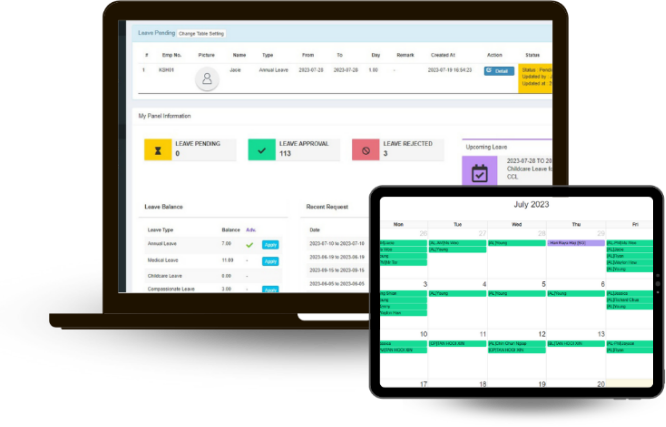Running a small or medium-sized enterprise (SME) in Malaysia is no walk in the park. Business owners are constantly balancing tight budgets, limited manpower, and increasing demands for efficiency. Amid these operational pressures, one area is often left behind: human resources.
Many SMEs still manage HR functions manually—spreadsheets for payroll, WhatsApp chats for leave approvals, and physical files for employee records. While this may seem manageable in the early stages, things quickly become chaotic as the team grows. Disorganized HR processes can lead to compliance issues, employee dissatisfaction, and costly errors.
This is exactly why Human Resource Management Systems are gaining traction among SMEs in Malaysia.
The Current HR Reality for Malaysian SMEs

Most SME founders didn’t start their business to manage payslips or track annual leave balances, but without effective HR management systems, HR issues can snowball fast if left unchecked. Here are some of the most common HR challenges faced by SMEs in Malaysia.
1. Leave Approvals Are Scattered and Confusing
Many companies still rely on verbal confirmations, text messages, or emails to manage leave requests, which complicates their hr management systems.
- Overlapping leave dates
- Poor record-keeping
- Payroll calculation errors
- Employee dissatisfaction due to perceived favoritism
2. Attendance Is Manually Tracked—or Not at All
Without modern hrm systems, monitoring punctuality or working hours becomes unreliable, complicating employee data management.
- Employees work remotely or on flexi-hours
- Late arrivals or early clock-outs go unnoticed
- Overtime claims become difficult to verify
3. Performance Appraisals Are Delayed or Forgotten
In an SME environment, structured performance management reviews are often the first to be sacrificed when things get busy without a proper management system.
- Reviews become subjective or irregular
- Staff feedback is undocumented
- Career progression becomes unclear
- High performers may feel undervalued and leave
4. HR Is Handled by Non-HR Staff
In many SMEs, HR isn’t a full-time function, but a side responsibility handled by:
- The business owner
- An accounts clerk
- A junior admin assistant
This leads to burnout, delayed tasks, and critical HR functions being sidelined.
Why Now? The Tipping Point for Malaysian SMEs
The business environment is changing. With more SMEs scaling rapidly, managing human capital efficiently has become a competitive advantage.
Here are the key drivers pushing SMEs toward hrm systems today:
- Hybrid & Remote Work: Flexible work arrangements are here to stay. SMEs need digital tools to manage attendance and productivity remotely.
- Compliance Requirements: From EPF to SOCSO and EIS, compliance can be a nightmare without proper records.
- Talent Retention: Employees expect transparency, self-service options, and clear growth paths. A systemized HR process helps deliver this.
- Payroll Accuracy: Mistakes in payroll lead to mistrust and frustration. Automation minimizes human error.
What an HRM System Can Do for SMEs
Many HR management systems designed for SMEs, particularly tailored for Malaysian businesses, can drastically enhance employee data management and payroll processes.
Centralize All HR Data
No more silos with modern HR management systems. Store employee records, contracts, leave balances, appraisals, and attendance logs in one place, accessible anytime, from anywhere.
Automate Leave Requests & Approvals
With modern HRMS systems, employees can apply for leave online, while managers receive automated notifications and can approve requests in one click.
Digital Time Tracking
Whether via biometric devices, mobile apps, or manual inputs, attendance is captured accurately for effective workforce management.
Payroll & Statutory Compliance
Payroll integrates seamlessly with attendance and leave data, enhancing the human resource management system by automatically calculating net pay, EPF, SOCSO, PCB, and generating pay slips.
Structured Appraisals
Run quarterly or annual reviews with customized templates using modern HRMS tools. Schedule reminders, collect feedback, and align KPIs with real business goals.
Employee Self-Service
Empower staff to check pay slips, apply for leave, or update their personal details using modern HRMS solutions without needing HR involvement.
Reports & Insights
Generate reports on headcount, absenteeism, late arrivals, and payroll trends to support smarter decision-making.
Million HRM
If you’re looking for an HRM system that’s easy to use, locally supported, and built for Malaysian businesses, Million HRM is a trusted choice!
There are many HRMS providers in Malaysia that offer competitive human resource and management solutions, but only a few were able to truly tick the boxes of SMEs who are looking for a multifunctional, efficient, and most of all, cost-effective software like Million!
Here’s what makes it stand out:
Locally Built for Malaysian Businesses
Million HRM understands the nuances of Malaysian payroll laws, leave entitlements, and statutory compliance (EPF, SOCSO, PCB, EIS, etc.). This human resource management system is tailored to your operational reality, not just an imported system with generic features.
User-Friendly Interface

You don’t need an IT team to get started with modern HRMS solutions. Million HRM’s dashboard is intuitive and requires minimal training for your HR team.
Flexible Modules
Only pay for the features you need. If you want a basic payroll solution or a full-suite HR management system with appraisals, attendance, and reporting, you can scale as needed.
Reliable Local Support

Having local customer service means issues are resolved faster, and hr management systems support teams understand your unique business environment.
What Happens If You Don’t Upgrade Your HR System?
Failing to modernize your HR operations with effective HR management systems isn’t just a matter of inefficiency—it’s a serious risk that can hurt your business in ways you might not immediately notice, until it’s too late.
Time Wasted on Manual Admin
Manual HR processes are time-consuming, particularly when utilizing outdated management systems. Tasks such as processing payroll, tracking leave balances, and updating employee records consume hours each month, especially if managed through spreadsheets or scattered communication tools. This time could be better spent on strategic activities like business development, customer service, or employee training.
Payroll Mistakes That Trigger Staff Disputes
Without an effective HR management system that automatically links attendance, leave, and pay data, payroll becomes vulnerable to errors like miscalculations, missed deductions, or late payments. Even a small mistake can damage employee trust, result in complaints, and create unnecessary tension in the workplace. Worse, repeated errors can lead to staff resignations or legal disputes.
Missed Statutory Deadlines and Penalties
In Malaysia, SMEs must comply with strict statutory obligations like EPF, SOCSO, EIS, and PCB filings. Relying on manual reminders or outdated HR management systems increases the likelihood of missing submission dates or underpaying contributions, both of which can lead to fines, audits, or legal consequences from government bodies like LHDN or KWSP.
Poor Employee Experience = Higher Turnover
Today’s workforce expects digital convenience. When your HR management systems still involve physical forms, delayed responses, or no transparency around leave entitlements and payroll, employees become frustrated. This can quickly turn into disengagement and resignation, especially among younger, tech-savvy staff who won’t tolerate outdated HR software.
Lack of Insights into Workforce Performance
When HR data is siloed or scattered across various files and folders, gaining insight into your team’s performance becomes nearly impossible. You won’t know who’s consistently late, who’s at risk of burnout, or where you need to invest in employee training. Without this visibility, you’re flying blind—and that limits your ability to lead effectively in modern HRMS.
Compliance Risk and Operational Exposure
As Malaysia updates its labor laws and privacy standards, companies that continue with manual or ad-hoc HR processes are increasingly exposed to compliance breaches. This could involve mishandling employee data, failing to document appraisals, or not keeping accurate attendance logs—all of which could have legal implications.
In short: not upgrading your HR system doesn’t just slow you down—it puts your business at risk. What was once a harmless spreadsheet becomes a liability as your team grows. In today’s competitive landscape, manual HR isn’t just old-fashioned—it’s operationally dangerous and a growth blocker.
Final Thoughts: It’s Time to Upgrade Your HR Game
If you’re still managing HR on Excel sheets or scribbled leave notes on your desk calendar, it’s time to admit—it’s no longer sustainable. The cost of inefficiency is too high in today’s business landscape.
An HRM system isn’t just about making life easier—it’s about positioning your SME to scale confidently, retain talent, and stay compliant.
Ready to Make the Switch?
Your business deserves better than spreadsheets and sticky notes.
Explore Million HRM now and take the first step toward transforming your HR function.








